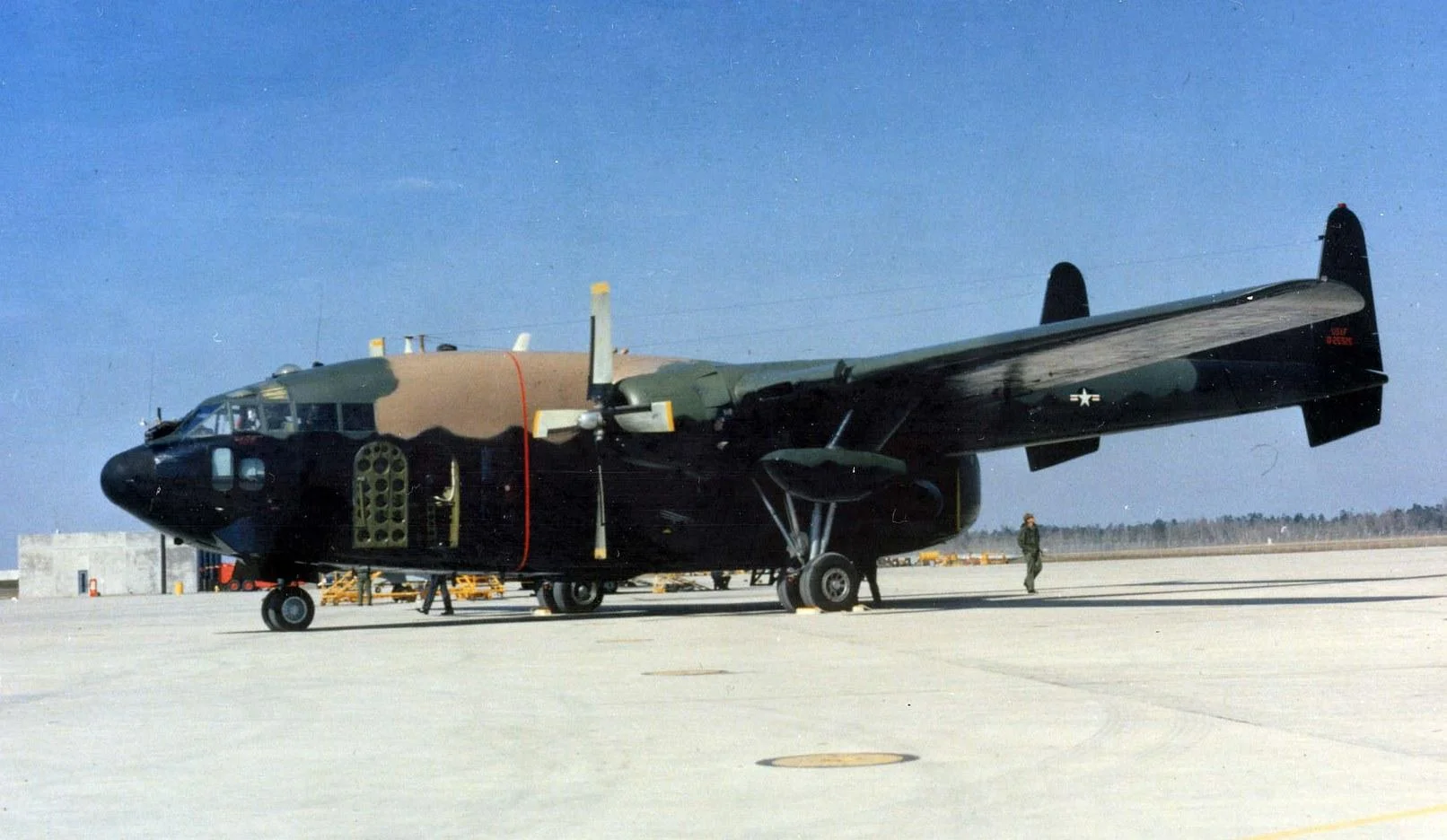The Vietnam War is usually discussed in terms of the experience on the ground. There was significant air support, including a fixed-wing gunship that gets relatively short shrift in terms of press coverage compared to the AC-47 “Spooky” (AKA “Puff the Magic Dragon”) and AC-130 Spectre gunships.
Boxy Beginnings: The C-119 Flying Boxcar
The AC-119s had their roots in the (originally) unarmed Fairchild C-119 Flying Boxcar (AKA the R4Q in U.S. Navy and Marine Corps parlances), a transport plane designed to do everything from dropping paratroopers and parachute-borne inanimate cargo to carrying litter patients to hauling mechanized equipment.
The twin-boom Flying Boxcar made her maiden flight on November 17, 1947, two months after the U.S. Air Force officially became a separate branch of service, and officially entered into operational service in December 1949. All versions of the C-119 were manufactured by Fairchild Aircraft, which is now M7 Aerospace, the American subsidiary of Israeli defense contractor Elbit Systems Ltd.
Among the C-119s claims to fame were its extensive usage during the 1954 siege of Dien Bien Phu and being among the aircraft types that mysteriously vanished in the infamous Bermuda Triangle (though, granted, not as famous as the disappearance of the Flight 19 Avenger torpedo bombers or the U.S. Navy collier USS Cyclops [AC-4]).
AC-119G Shadow and AC-119K Stinger Specifications
The decision was made to start converting the Flying Boxcars into gunships was twofold: the Spooky was considered underpowered (plus it was WWII vintage and therefore starting to get a bit long in the tooth) and as badass as the Spectre was, the C-130 Hercules airframes were desperately needed for cargo transport first and foremost. Ergo, the C-119 platform was chosen to fill in the gap.
The project started off with the AC-119G Shadow, which had four GAU-2/A (M134) miniguns in 7.62x51mm NATO caliber, which had a variable rate of fire from 2,000 – 6,000 rounds per minute. Shortly thereafter came the AC-119K Stinger, which upped the firepower ante by tacking on two M61 Vulcan 20mm cannons with a 6,000 rpm rate of fire; the Stinger also got a propulsion boost in the form of two General Electric J85 turbojet engines in underwing pods.
Additional specifications for the AC-119G included a fuselage length of 86 feet 5.75 inches, a wingspan of 109 feet 3.25 inches, and a height of 26 feet 7.75 inches. The empty weight was 40,125 pounds and the maximum takeoff weight was 62,000 pounds. Max airspeed was 180 knots (210 miles per hour) with a cruise speed of 130 knots (150 mph), a range of 1,680 nautical miles, and a service ceiling of 23,300 feet.
Out of 1,183 Flying Boxcars built, 52 were converted to either Shadows or Stingers.
Vietnam Performance
Initially the AC-119 gunships were deadly effective. For example, according to a document furnished by the AC-119 Gunship Association:
“During the last 6 months of 1970, the Stingers destroyed 275 vehicles & damaged another 275. On 16 December 1970, an AC-119K set the year’s record for total trucks destroyed or damaged by all types of gunships. This record for one mission was 29 trucks destroyed & 6 damaged. During this same period they also destroyed 279 sampans & damaged 64 … The Stinger gunships were also often withdrawn from truck hunting activity to provide close air support for troops in contact. Support of troops in contact during 1970 accounted for 329 confirmed enemy killed by air.”
Alas, all good things must come to an end, and that includes the AC-119’s glory days: “The Air Force phased out its last AC-119 in 1973. By the time the South Vietnamese began flying the AC-119K, its time had passed as a weapon of interdiction. Not even the AC-130 could roam at will over an expanded & better defended Ho Chi Minh Trail.”
Where Are They Now?
Although there are a goodly number of unarmed C-119 Flying Boxcars around today – including two airworthy specimens privately owned by a Mr. John S. Reffett of Eagle River, Alaska – there is only one sole survivor from the gunship iteration, that being AF serial number 53-3144, on static display at the Air Commando Heritage Park at Hurlburt Field, Florida, home of Air Force Special Operations Command (AFSOC).
Christian D. Orr is a former U.S. Air Force Security Forces officer, Federal law enforcement officer, and private military contractor (with assignments worked in Iraq, the United Arab Emirates, Kosovo, Japan, Germany, and the Pentagon). Chris holds a B.A. in International Relations from the University of Southern California (USC) and an M.A. in Intelligence Studies (concentration in Terrorism Studies) from American Military University (AMU). He has also been published in The Daily Torch and The Journal of Intelligence and Cyber Security. Last but not least, he is a Companion of the Order of the Naval Order of the United States (NOUS).
From 19FortyFive
A Russian Submarine Accidently ‘Destroyed Itself’
Total Massacre’: Ukraine Footage Shows Russian Cruise Missile Shipment Attacked

